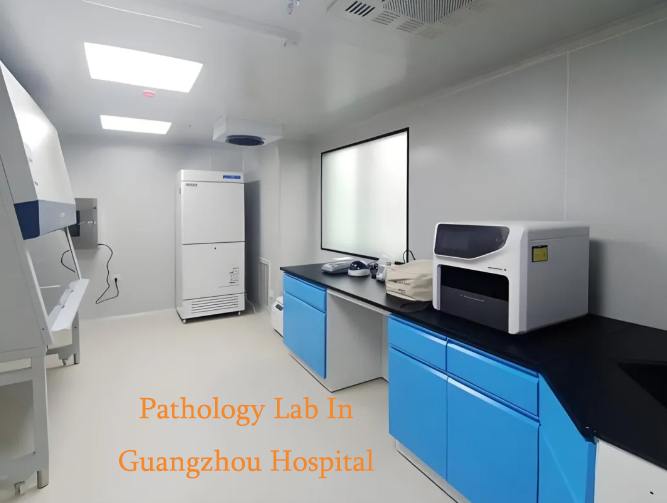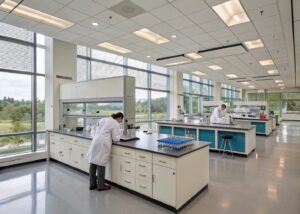Table of Contents
Setting up a pathology lab requires careful planning, as it involves working with sensitive biological samples and hazardous materials. The goal is to create an efficient workspace that maximizes safety, ensures accurate results, and reduces the risk of contamination. This guide to pathology lab setup will walk you through essential considerations, from zoning the lab to ensuring proper ventilation and environmental controls.
Zoning: Organizing the Lab for Optimal Workflow
In a pathology lab, contamination control is a top priority. The workspace must be organized into distinct areas to handle both biological and nucleic acid contamination. The division of the lab into zones prevents cross-contamination, ensures smooth workflow, and enhances safety for staff.
Biological and Nucleic Acid Zones
- Biological Pollution Zones: These include areas where body fluids and tissue samples are processed, such as the sample receiving and pre-treatment areas.
- Nucleic Acid Contamination Zones: These are designated for nucleic acid handling activities such as extraction, amplification, and analysis. Nucleic acid contamination poses a high risk during PCR and DNA/RNA work.
Each of these zones should be further divided into:
- Contaminated Area: Where samples are handled.
- Semi-Contaminated Area: Transitional spaces.
- Clean Area: Areas free from contaminants, like office spaces or data analysis rooms.
This separation is essential to prevent cross-contamination between different phases of testing and processing, ensuring accurate diagnostic results.
Key Functional Areas in a Pathology Lab Setup
A well-organized pathology lab setup is divided into functional areas according to the workflow and the types of tests conducted. Below are the key areas that should be included:
Sample Receiving Area
This is the first point of contact for samples. It’s where body fluids, paraffin blocks, or biopsy samples arrive. Important tasks like checking patient details, registering samples, and storing them at the appropriate temperature (usually at 4℃ for body fluids) are handled here.
Sample Pre-treatment Area
In this zone, technicians prepare samples for analysis. This includes tasks like sectioning tissue samples, dewaxing, staining, and centrifuging specimens. Each sample type, whether blood, urine, or tissue, requires specific preparation techniques, making this area critical for accurate diagnoses.
Reagent Storage and Preparation Area
This area must be equipped with refrigerators and freezers to store reagents under specific conditions, typically divided into:
- Room Temperature Storage: 18℃-26℃
- Refrigerated Storage: 2℃-8℃
- Frozen Storage: Below -20℃
Proper labeling and storage are essential for the safety and longevity of reagents used in testing.
Sample Preparation Area
This zone handles DNA and RNA extraction from samples. It must be equipped with an external exhaust-type biosafety cabinet to protect staff from harmful aerosols generated during the process. This area plays a pivotal role in molecular pathology testing, where accurate sample preparation is crucial for successful downstream testing like PCR.
PCR Amplification and Nucleic Acid Fragmentation Areas
These areas are dedicated to the most contamination-sensitive tasks, such as nucleic acid amplification and electrophoresis detection. These zones should be highly controlled, with strict protocols to avoid nucleic acid aerosol contamination. Any error in handling here can lead to compromised test results.
Sequencing and Data Analysis Areas
Once the amplification process is complete, the next step is sequencing and analysis. These areas house sensitive equipment like sequencers and data analysis software. Even though they do not generate nucleic acid aerosols, proper ventilation and contamination control measures are still necessary.
Airflow and Ventilation: Preventing Cross-Contamination
Effective airflow management is a critical element in pathology lab setup. Proper ventilation prevents the spread of nucleic acid aerosols and other contaminants, which is particularly important in areas where PCR or DNA/RNA work is performed.
- Top-to-Bottom Airflow: Air should flow downward to help keep contaminants away from work surfaces.
- Independent Ventilation Systems: Each zone should have its own ventilation system to avoid cross-contamination between areas.
- Negative Pressure: Installing negative pressure systems in contamination zones ensures that air flows from clean areas to contaminated ones, reducing the risk of exposure to harmful particles.
The recommended air exchange rate is 12-16 times per hour, especially in rooms that handle hazardous materials or generate aerosols.
Temperature and Humidity Control: Protecting Sensitive Equipment and Samples
In pathology labs, temperature and humidity control play an important role in ensuring reliable testing results. Precision instruments, such as sequencers and PCR machines, require stable environmental conditions.
- Temperature Range: 18℃-26℃
- Humidity Range: 30%-70%
Fluctuations in these parameters can cause sample degradation or equipment malfunction, affecting the accuracy of test results. Therefore, the lab should have systems in place to maintain a consistent environment, with a temperature fluctuation of less than 2℃ within 2 hours.
Hazardous Chemical and Reagent Storage: Ensuring Safety and Compliance
Pathology labs frequently use hazardous chemicals, such as corrosive reagents, flammable substances, and toxic solvents. Proper storage is essential to prevent accidents and ensure compliance with safety regulations.
- Separate Hazardous Chemicals Storage: This area should be isolated from the main laboratory and office areas, with appropriate ventilation and explosion-proof measures in place.
- General Storage: Non-hazardous materials like pipette tips and centrifuge tubes should be stored in a separate general warehouse.
Office and Staff Rest Areas: Providing a Safe, Clean Workspace
Although most of the lab is focused on experimental work, it is also important to allocate space for laboratory personnel to rest, work, and study. The office area should be located away from contamination zones, providing a clean, quiet environment for staff to handle administrative tasks and data analysis.
Conclusion
Designing a pathology lab involves more than just setting up equipment and workspaces. It requires a thorough understanding of how contamination can occur and how to mitigate it. By carefully dividing the lab into functional zones, ensuring proper airflow and environmental controls, and providing safe storage for reagents and chemicals, you can create a laboratory that operates efficiently, safely, and in compliance with industry standards.
If you’re planning your pathology lab setup, paying attention to these details will help ensure that your lab runs smoothly and produces accurate, reliable results. Proper lab design not only enhances productivity but also protects the health and safety of your staff.




